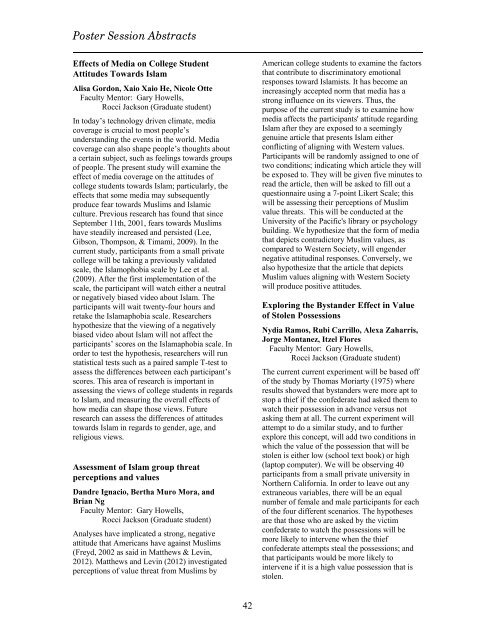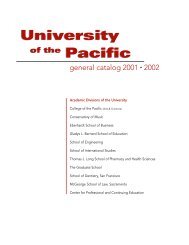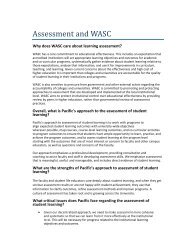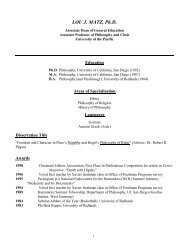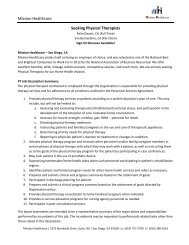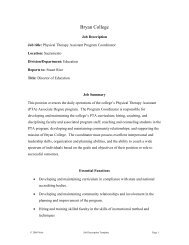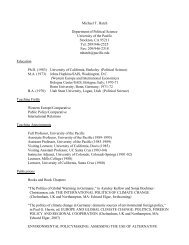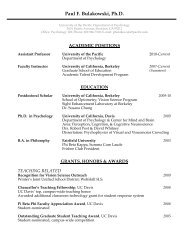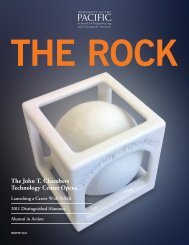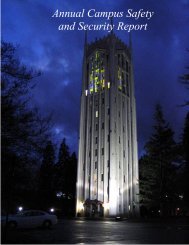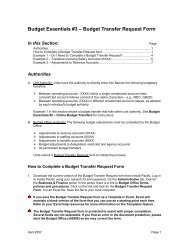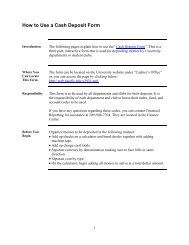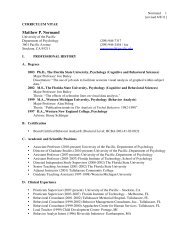purcc 2012 - University of the Pacific
purcc 2012 - University of the Pacific
purcc 2012 - University of the Pacific
You also want an ePaper? Increase the reach of your titles
YUMPU automatically turns print PDFs into web optimized ePapers that Google loves.
Poster Session Abstracts<br />
Effects <strong>of</strong> Media on College Student<br />
Attitudes Towards Islam<br />
Alisa Gordon, Xaio Xaio He, Nicole Otte<br />
Faculty Mentor: Gary Howells,<br />
Rocci Jackson (Graduate student)<br />
In today’s technology driven climate, media<br />
coverage is crucial to most people’s<br />
understanding <strong>the</strong> events in <strong>the</strong> world. Media<br />
coverage can also shape people’s thoughts about<br />
a certain subject, such as feelings towards groups<br />
<strong>of</strong> people. The present study will examine <strong>the</strong><br />
effect <strong>of</strong> media coverage on <strong>the</strong> attitudes <strong>of</strong><br />
college students towards Islam; particularly, <strong>the</strong><br />
effects that some media may subsequently<br />
produce fear towards Muslims and Islamic<br />
culture. Previous research has found that since<br />
September 11th, 2001, fears towards Muslims<br />
have steadily increased and persisted (Lee,<br />
Gibson, Thompson, & Timami, 2009). In <strong>the</strong><br />
current study, participants from a small private<br />
college will be taking a previously validated<br />
scale, <strong>the</strong> Islamophobia scale by Lee et al.<br />
(2009). After <strong>the</strong> first implementation <strong>of</strong> <strong>the</strong><br />
scale, <strong>the</strong> participant will watch ei<strong>the</strong>r a neutral<br />
or negatively biased video about Islam. The<br />
participants will wait twenty-four hours and<br />
retake <strong>the</strong> Islamaphobia scale. Researchers<br />
hypo<strong>the</strong>size that <strong>the</strong> viewing <strong>of</strong> a negatively<br />
biased video about Islam will not affect <strong>the</strong><br />
participants’ scores on <strong>the</strong> Islamaphobia scale. In<br />
order to test <strong>the</strong> hypo<strong>the</strong>sis, researchers will run<br />
statistical tests such as a paired sample T-test to<br />
assess <strong>the</strong> differences between each participant’s<br />
scores. This area <strong>of</strong> research is important in<br />
assessing <strong>the</strong> views <strong>of</strong> college students in regards<br />
to Islam, and measuring <strong>the</strong> overall effects <strong>of</strong><br />
how media can shape those views. Future<br />
research can assess <strong>the</strong> differences <strong>of</strong> attitudes<br />
towards Islam in regards to gender, age, and<br />
religious views.<br />
Assessment <strong>of</strong> Islam group threat<br />
perceptions and values<br />
Dandre Ignacio, Bertha Muro Mora, and<br />
Brian Ng<br />
Faculty Mentor: Gary Howells,<br />
Rocci Jackson (Graduate student)<br />
Analyses have implicated a strong, negative<br />
attitude that Americans have against Muslims<br />
(Freyd, 2002 as said in Mat<strong>the</strong>ws & Levin,<br />
<strong>2012</strong>). Mat<strong>the</strong>ws and Levin (<strong>2012</strong>) investigated<br />
perceptions <strong>of</strong> value threat from Muslims by<br />
American college students to examine <strong>the</strong> factors<br />
that contribute to discriminatory emotional<br />
responses toward Islamists. It has become an<br />
increasingly accepted norm that media has a<br />
strong influence on its viewers. Thus, <strong>the</strong><br />
purpose <strong>of</strong> <strong>the</strong> current study is to examine how<br />
media affects <strong>the</strong> participants' attitude regarding<br />
Islam after <strong>the</strong>y are exposed to a seemingly<br />
genuine article that presents Islam ei<strong>the</strong>r<br />
conflicting <strong>of</strong> aligning with Western values.<br />
Participants will be randomly assigned to one <strong>of</strong><br />
two conditions; indicating which article <strong>the</strong>y will<br />
be exposed to. They will be given five minutes to<br />
read <strong>the</strong> article, <strong>the</strong>n will be asked to fill out a<br />
questionnaire using a 7-point Likert Scale; this<br />
will be assessing <strong>the</strong>ir perceptions <strong>of</strong> Muslim<br />
value threats. This will be conducted at <strong>the</strong><br />
<strong>University</strong> <strong>of</strong> <strong>the</strong> <strong>Pacific</strong>'s library or psychology<br />
building. We hypo<strong>the</strong>size that <strong>the</strong> form <strong>of</strong> media<br />
that depicts contradictory Muslim values, as<br />
compared to Western Society, will engender<br />
negative attitudinal responses. Conversely, we<br />
also hypo<strong>the</strong>size that <strong>the</strong> article that depicts<br />
Muslim values aligning with Western Society<br />
will produce positive attitudes.<br />
Exploring <strong>the</strong> Bystander Effect in Value<br />
<strong>of</strong> Stolen Possessions<br />
Nydia Ramos, Rubi Carrillo, Alexa Zaharris,<br />
Jorge Montanez, Itzel Flores<br />
Faculty Mentor: Gary Howells,<br />
Rocci Jackson (Graduate student)<br />
The current current experiment will be based <strong>of</strong>f<br />
<strong>of</strong> <strong>the</strong> study by Thomas Moriarty (1975) where<br />
results showed that bystanders were more apt to<br />
stop a thief if <strong>the</strong> confederate had asked <strong>the</strong>m to<br />
watch <strong>the</strong>ir possession in advance versus not<br />
asking <strong>the</strong>m at all. The current experiment will<br />
attempt to do a similar study, and to fur<strong>the</strong>r<br />
explore this concept, will add two conditions in<br />
which <strong>the</strong> value <strong>of</strong> <strong>the</strong> possession that will be<br />
stolen is ei<strong>the</strong>r low (school text book) or high<br />
(laptop computer). We will be observing 40<br />
participants from a small private university in<br />
Nor<strong>the</strong>rn California. In order to leave out any<br />
extraneous variables, <strong>the</strong>re will be an equal<br />
number <strong>of</strong> female and male participants for each<br />
<strong>of</strong> <strong>the</strong> four different scenarios. The hypo<strong>the</strong>ses<br />
are that those who are asked by <strong>the</strong> victim<br />
confederate to watch <strong>the</strong> possessions will be<br />
more likely to intervene when <strong>the</strong> thief<br />
confederate attempts steal <strong>the</strong> possessions; and<br />
that participants would be more likely to<br />
intervene if it is a high value possession that is<br />
stolen.<br />
42


